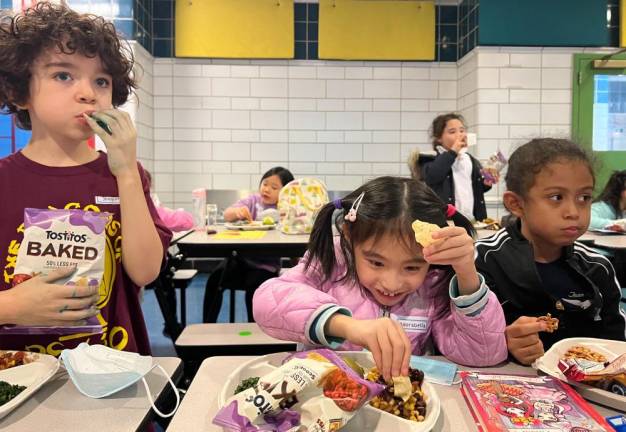The Politics of School Lunch
Beyond “Ketchup as a Vegetable”: a brief history of the debate over public-school meals, as Adams declares Vegan Fridays in schools

Earlier this month, New York City Mayor Eric Adams launched “Vegan Fridays,” a public-school initiative that met with harsh criticism when meals failed to meet expectations by the time of their launch. Parents of NYC schoolchildren took to Twitter to expose their kid’s cheese burritos and meager lunch plates, eliciting doubt from the media that vegan school lunches are feasible in the long run. In the battlefield that is the federally funded lunch program, this scandal isn’t a first. So, in light of recent backlash, it’s worth taking a look back at the history of school lunches as they’ve elicited similar debate over time.
Background
Up until the 1930s, school lunches were provided only in large, industrial cities. By 1913 in NYC, the New York Association for Improving the Condition of the Poor (NYAICP) made it a goal to serve public school meals at a cost of one cent each, a modern equivalent of just under a dollar. Fixed meals consisted of combinations of soup and rice or mashed potatoes and bread. A la carte, a child could purchase dessert.
During the Great Depression, the US Government made the decision to widen the availability of school lunches, and by the early 1940s nearly one third of the country’s schoolchildren were eligible for aid. Despite the growing programs, parents and other caregivers were widely unsatisfied with the United States Department of Agriculture’s (USDA) methods of obtaining the food. While school boards were given budgets to acquire a majority of locally grown food and produce, the USDA sought to keep prices low by purchasing unwanted products that farmers couldn’t sell at normal prices. As a result, schools were overwhelmed with unwanted food that they could not properly store.
National School Lunch Act
In 1946, the National School Lunch Act made free or reduced-price lunches more accessible to lower income students, with goals to “encourage the domestic consumption of nutritious agricultural commodities” and “safeguard the health and well-being of the nation’s children.” At the time, it was reported that nearly 40% of all draft rejects were turned away for poor diets, and some believed that the new lunch law was incentivized by military needs at the time. Regardless, its successes prompted the Child Nutrition Act of 1966, which expanded on earlier nutrition standards and funded a new School Breakfast Program.
“Ketchup as a Vegetable”
The infamous “Ketchup as a Vegetable” scandal followed The Omnibus Reconciliation Acts of 1980 and 1981, which decreased funding for school lunch programs by eight and twenty-five percent respectively. But despite the intended cut of over $1 billion, schools were still expected to meet federal caloric and nutritional requirements. A solution, or loophole, suggested by the USDA’s Food and Nutrition Service (FNS) to preserve lunch programs in lower income schools, manipulated the way foods could be categorized to fit nutrition standards. Under these guidelines, doughnuts met the requirements for bread, and relish a serving of vegetables. The media was outraged; by this logic, many said, ketchup could count as a vegetable.
“Ketchup is a condiment,” said Sen. John Heinz of the H.J. Heinz Co. family in 1981. “This is one of the most ridiculous regulations I ever heard of.” But despite its classification as a fruit, the statement stuck. While ketchup as a vegetable was not an official comment of government programs or even the original FNS report, the sentence became a symbol of the government’s disregard for low-income communities and their children.
This wasn’t the last time a tomato product would become a topic of political debate. In November of 2011, the scandal managed to reappear when the US Department of Agriculture proposed that a half-cup of tomato paste could fulfill a vegetable nutrition requirement in schools. A major ingredient of tomato sauce, the media got to work on their newest headline: “US Congress rules that pizza is a vegetable.” While the proposal contained no such quote, the statement became another calling card for the government’s inadequate approach to school lunches. Only this time, the proposal gained support in its defense. Some news outlets, like The Washington Post, defended the statement by comparing nutritional information of other fruits and vegetables with cans of tomato paste. For a moment, it seemed that both the media and the public forgot that the tomato is in fact, a fruit.
Recent Years
In 2010, The Healthy, Hungry-Free Kids Act raised federal spending on school lunches and implemented a caloric limit on meals in an effort to fight rapidly increasing rates of childhood obesity. However, throughout the 2010s and into the past several years, public-school lunches continue to be criticized for their lack of appeal, as commitment to their quality continues to be looked over. In the face of obesity rates in NYC public school children reaching 40%, the switch to healthier options only offers a solution if the meals can be properly executed.
Adams has recently been questioned on such issues. If vegan Friday lunches are going to bring their intended nutritional benefit, children need to want to eat them. The solution then, isn’t an opposition to healthy school lunches, but a plan and a budget that will meet both rapidly changing nutrition standards, as well as the desires of hungry schoolchildren.
“If we have to pay a little more to make sure that these perishable items are available, that’s a better investment,” said the mayor on February 10 as he addressed quality control in the new program. “We are transforming how we feed people in our city.”